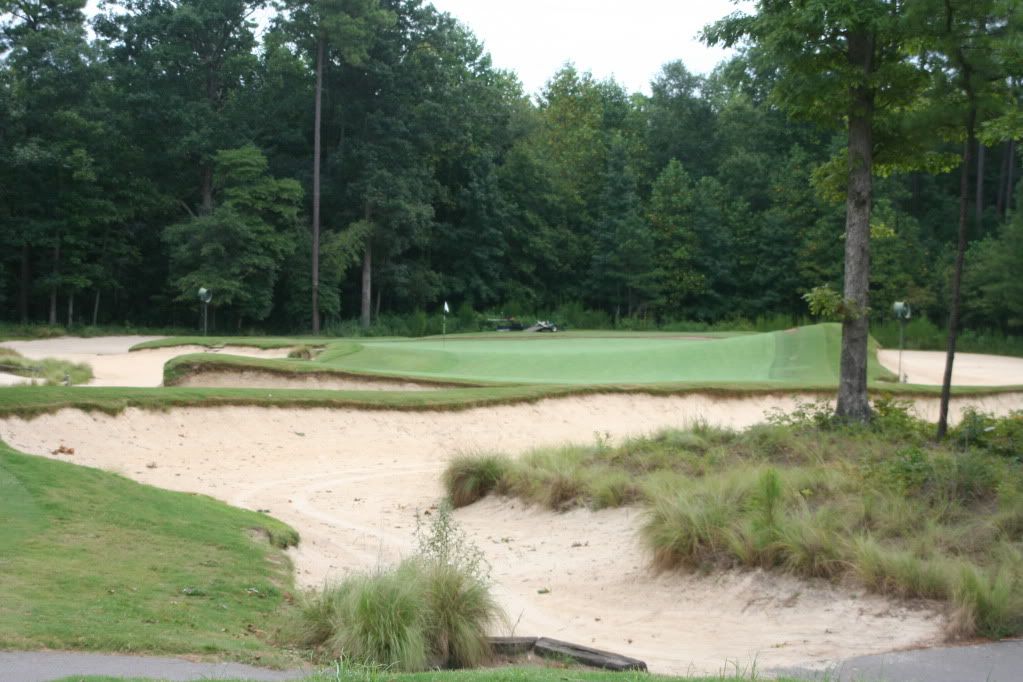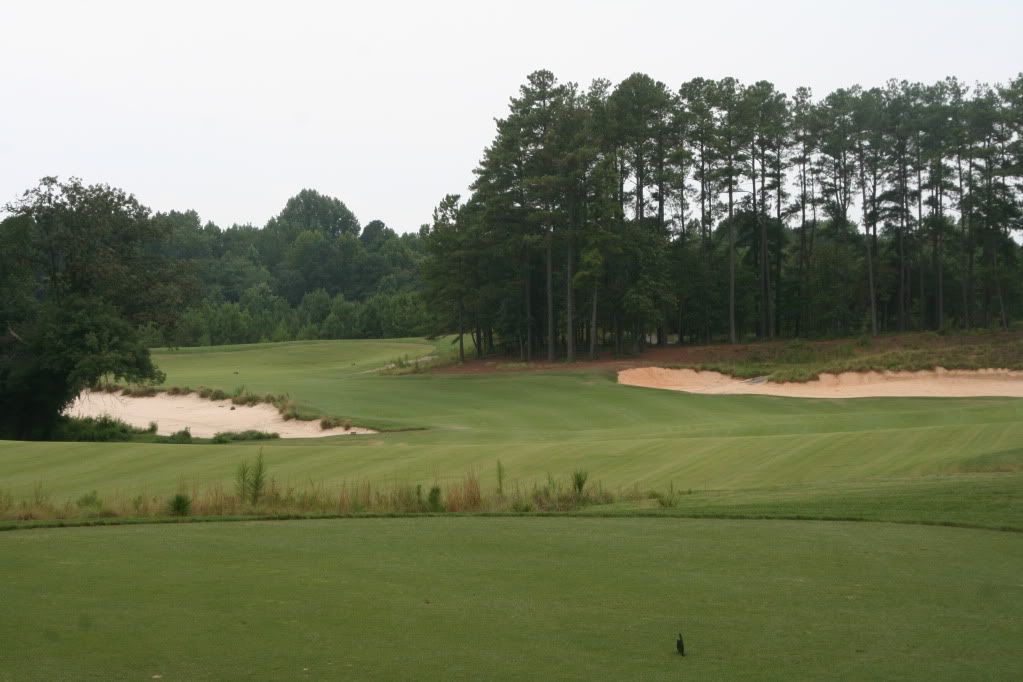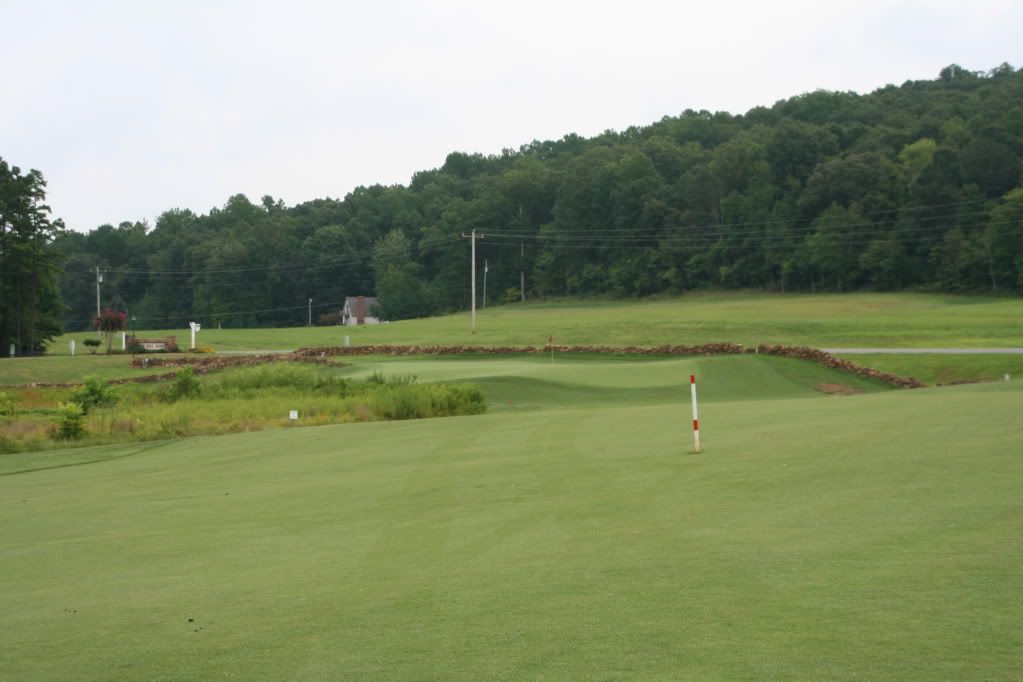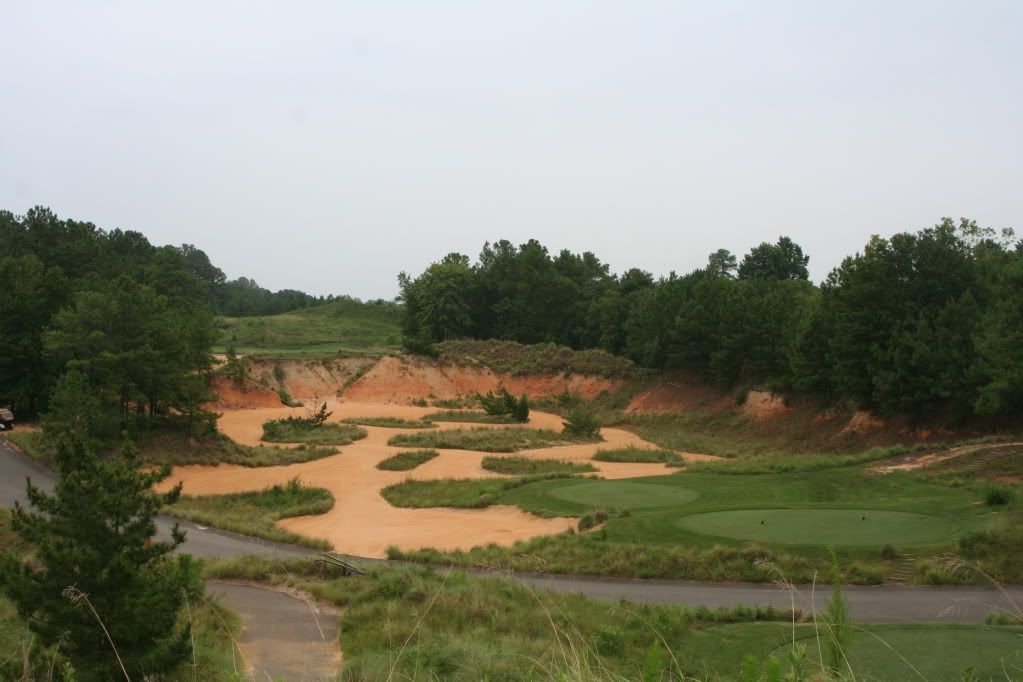The most well known of the Macdonald School holes are the Biarritz, Redan, Punchbowl, Sahara, Cape, Road, and Alps. All of these holes show up at least once on Strantz courses, some of them more. Certainly Strantz went and put his own unique touch on these holes, but the strategic features are still there.
All images, with exception of Bulls Bay images, taken by and used with permission from The Buffalo Golfer: http://www.buffalogolfer.com
Bulls Bay images taken by and used with permission from S. R. Arble.
Biarritz
This is a hole that Strantz created twice. The basic feature of the biarritz hole has been described here before, but generally the hole is defined by a large depression in the middle of the green running side to side. The player is given the opportunity to bring the ball in low, landing it on the front of the green, and rolling to the back.
Tobacco Road, Hole #3, 152 yards
Here, the green starts just beyond the front bunkers, dips down, and rises sharply to the back level. Perhaps not a true Biarritz given that the back level is above that of the front, but the depression and two tiered green is there.
Royal New Kent, Hole #7, 197 yards
This hole is a biarritz/redan hybrid. The depression with two tiers is there, but so is the right-to-left angle and the front kick slope. Strantz used the creek bed in lieu of a bunker as the fronting hazard and put the two pot bunkers in as the rear hazard. The bunkers short of the kick slope are traditional redan features.
Redan
Strantz also crafted this hole twice. The standard Redan has a green that is angled roughly forty-five degrees right-to-left away from the player. Traditionally, the hole has a deep bunker fronting the green and another bunker behind the green to catch shots going long. The hole is also marked by the front to back slope, allowing the players to roll the ball to the back of the green, and the bunkers that are typically short of the front kick slope, bringing distance control more into focus for the player.
Royal New Kent, Hole #7, 197 yards
--Profiled above
Bulls Bay, Hole #7, 180 yards
This hole features the standard Redan shape and the front slope into the opening, However, it lacks the cross bunkers and rear bunker.
Punchbowl
This is a hole that Strantz used a number of times. The basic idea of the Punchbowl is that the green is located in a natural bowl or depression. The slopes of the depression can either be part of the green or part of the surrounding area.
Tobacco Road, Hole #13, 573 yards
This green is most certainly located in a bowl. Much of the green is obscured from view when approaching from the fairway. Options could be incredible if the bowl walls were maintained with shorter turf rather than high love grass.
Bulls Bay, Hole #14, 190 yards
Here, you can see the entire rear and both sides of the green sloping down towards the center of the green. In this case, a portion of the surround is maintained as short turf. This gives the player the chance to use the slope to get a shot closer to the hole...or might improve the positioning of a poorly played shot as well.
Stonehouse, Hole #5, 431 yards
The features are fairly obvious here. Slopes coming into the center from all directions. This might be the most traditional of the punchbowls shown.
Cape
This hole has become something different than it originally was. The original Cape played as a dogleg but the green was located on a peninsula surrounded by water. The original hole has since been altered and today the Cape is typically defined as a dogleg hole where the player is given the option of picking a more or less aggressive line off the tee, typically cutting over some type of hazard. This hole concept is possibly the most copied hole in golf and Strantz made good use of the concept himself.
Tobacco Road, Hole #12, 419 yards
This hole bends significantly to the left around the bunker. The green is farther around the corner, not in the image. The player is able to play the tee shot as far out to the left as he dares.
Tot Hill Farm, Hole #5, 535 yards
While difficult to see in the image, the fairway here runs from right to left, away from the player. Inside the dogleg is a deep depression filled with small trees and shrubs. The most agressive line on this hole is towards the peak of the hill/mountain in the distance.
Royal New Kent, Hole #9, 407 yards
Here, the player is given the chance to pick his line over the creek that is just shy if the fairway. In prior years, the creek also served to separate the fairway on the left from a second fairway on the right. The bunkers await through the fairway to catch golfers getting a little too greedy on the conservative line.
Bulls Bay, Hole #5, 406 yards
This is the first of the Cape holes that really play over a water feature. The marshland must be carried here in order to reach the fairway and the player is able to play as far out right as he feels comfortable doing.
Road
As the name suggests, this hole is patterned after the Road hole 17th at The Old Course. The green typically is narrow and angles right to left. There is also normally a bunker short of the green, ideally a pot bunker to mimick the Road Hole Bunker and some type of hazard long of the green to represent the road itself.
This hole bears more than a passing resemblance to the Road Hole, even if it lacks the bunker short. The tall grass short provides the Road Hole Bunker feature and the wall long, there to keep balls from going onto the public road located about 10 yards beyond the hazard, provides the Road feature.
Alps
The idea here is typically to have some type of large hill feature obscuring the view of the green. Sometimes the player is given the chance to play to a disadvantaged side of the fairway in order to avoid it, other times that is not the case.
Tobacco Road, Hole #1, 558 yards
This from about 210 yards from the green, no sight of the green. The green sits about 75 yards beyond the mound in the center of the picture.
Royal New Kent, Hole #14, 344 yards
This hole allows the golfer the chance to see the green when playing to a proper location. Golfers who play tee shots to the flanks of the fairway will likely not be able to see the flag. This green is also located in a punchbowl.
Sahara
This hole plays up and over a dune or some type of sand feature that also prevents the player from seeing the ball come to rest in the fairway.
Tobacco Road, Hole #18, 432 yards
From the tee, this is what the player sees. The fairway begins directly over top of the hill but the vast majority of it is out of the player's view.
There are other examples that could be used for these hole type, certainly the Alps feature is one that Strantz uses with semi-regularity. Same with the Punchbowl. Also, you may note that no holes from True Blue and Caledonia, Strantz originals, or Monterey Peninsula (Shore) and Silver Creek Valley, Strantz redesigns, are mentioned here. I simply lack familiarity with those courses and am unable to determine if any of those holes fit into the template mold.
If you think I've missed any, and I probably have, feel free to let me know.
































